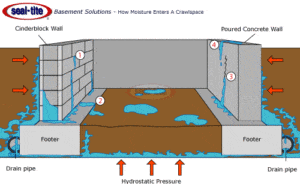Crawl space waterproofing is a crucial aspect of home maintenance that often goes overlooked until water-related issues arise. Protecting your crawl space from moisture is essential to prevent structural damage, mold growth, and other potential problems. In this comprehensive guide, we’ll explore various crawl space waterproofing methods to help you make informed decisions and keep your home safe and dry.
I. Understanding the Importance of Crawl Space Waterproofing
A. The Role of the Crawl Space in Home Structure
The crawl space, though often overlooked, plays a crucial role in the overall structural integrity and energy efficiency of a home. Situated between the ground and the first floor, the crawl space provides access to plumbing, electrical wiring, and other essential components. Its primary purpose is to allow proper ventilation and prevent the buildup of moisture beneath the house.
However, if left unprotected, the crawl space can become a breeding ground for various issues. Moisture is a common adversary, and when it infiltrates this space, it can lead to a host of problems. Wooden structural elements, such as beams and joists, are particularly susceptible to damage from prolonged exposure to moisture. Over time, this can result in wood rot, compromising the structural stability of your home.
B. Common Issues Caused by Moisture in Crawl Spaces
- Mold Growth: Excess moisture in the crawl space creates an ideal environment for mold growth. Mold poses health risks and can spread throughout the home, affecting indoor air quality. Certain types of mold release spores that can exacerbate respiratory issues and allergies.
- Pest Infestations: Damp crawl spaces attract pests like termites, ants, and rodents. These unwelcome guests can cause extensive damage to wooden structures and insulation, leading to costly repairs. Proper waterproofing measures act as a deterrent, reducing the risk of infestations.
- Structural Damage: Moisture-related issues can compromise the integrity of structural elements in the crawl space. Wood rot weakens support beams and floor joists, potentially resulting in sagging floors and other structural failures.
- Increased Energy Costs: A wet crawl space can contribute to increased humidity levels in your home. This, in turn, forces your HVAC system to work harder to maintain a comfortable indoor environment. Waterproofing your crawl space helps regulate humidity levels, reducing the strain on your heating and cooling systems and ultimately lowering energy costs.
Understanding these potential issues emphasizes the importance of implementing effective crawl space waterproofing methods. By proactively addressing moisture-related concerns, homeowners can protect their investment, enhance indoor air quality, and ensure the long-term stability of their homes. In the following sections, we will delve into specific signs indicating the need for crawl space waterproofing and explore various methods to safeguard this vital space.
II. Signs Your Crawl Space Needs Waterproofing
Your crawl space may not be the most visited area in your home, but it is essential to pay attention to signs that indicate potential moisture-related issues. Recognizing these signs early on can help you take prompt action to prevent extensive damage. Here are some key indicators that your crawl space may need waterproofing:
A. Musty Odors and Mold Growth
- Unpleasant Odors: If you notice musty or damp odors emanating from your crawl space, it could be a sign of excess moisture. These odors are often indicative of mold or mildew growth, which thrive in damp environments. Addressing the source of moisture is crucial to eliminate these unpleasant smells.
- Visible Mold and Mildew: Inspect the walls, floor, and structural components of your crawl space for visible signs of mold and mildew. Mold can appear as discolored patches or fuzzy growth on surfaces. Keep in mind that some molds may not be immediately visible, so a thorough inspection is essential.
B. Wood Rot and Structural Damage
- Decaying Wood: Wooden beams, floor joists, and other structural elements in the crawl space are susceptible to wood rot when exposed to moisture over an extended period. Check for any signs of decay, such as soft or crumbly wood, and address these issues promptly to prevent further structural damage.
- Sagging Floors: Excessive moisture can weaken the structural integrity of wooden supports, leading to sagging or uneven floors. If you notice any dips or unevenness in your flooring, it may be an indication of compromised structural elements in the crawlspace.
C. Increased Energy Bills
- Higher Humidity Levels: If your home experiences elevated humidity levels, especially in conjunction with musty odors, it could be a sign of moisture infiltration from the crawlspace. High humidity makes your HVAC system work harder to maintain comfort, resulting in increased energy consumption.
- Condensation on Windows: Check for condensation on windows, particularly in areas close to the crawl space. Excessive condensation suggests that indoor humidity levels are too high, often caused by moisture issues in the crawl space.
Identifying these signs early on empowers homeowners to take proactive measures to address crawl space moisture. In the next sections, we will explore various crawl space waterproofing methods, ranging from exterior excavation to interior solutions like vapor barrier barriers and encapsulation, to help you choose the most suitable approach for your home.
III. Crawl Space Waterproofing Methods
Effectively waterproofing your basement and crawl space involves a combination of preventive measures and targeted solutions tailored to your home’s specific needs. Below, we’ll explore various crawl space waterproofing methods, categorized into exterior and interior solutions, as well as drainage systems.
A. Exterior Excavation and Waterproofing
- Installation of French Drains: French drains are a widely used exterior waterproofing solution. These drains consist of a perforated pipe surrounded by gravel, installed along the exterior foundation of your home. They redirect water away from the foundation, preventing it from seeping into the crawl space. This method is particularly effective in areas with poor soil drainage.
- Application of Waterproof Membranes: Waterproof membranes, such as asphalt-based or rubberized coatings, can be applied to the exterior foundation walls. These membranes create a barrier that repels water, preventing it from penetrating the foundation. This method is often employed during new construction or as part of a comprehensive exterior waterproofing plan.
B. Interior Crawl Space Waterproofing
- Vapor Barriers and Encapsulation: Vapor barriers are sheets of material, typically made of polyethylene, installed on the crawl space floor and walls. This method, known as encapsulation, creates a barrier that prevents moisture from entering the space. Additionally, it helps regulate humidity levels, reducing the risk of mold growth and wood rot.
- Sump Pump Installation: Sump pumps are effective at managing water accumulation in the crawl space. A sump pump is installed in a pit, and when water levels rise, the pump activates to discharge water away from the foundation. This method is particularly useful in areas prone to heavy rainfall or where the water table is high.
- Dehumidification Systems: Installing a dehumidification system in the crawl space helps maintain optimal humidity levels. By removing excess moisture from the air, dehumidifiers contribute to a dry environment, preventing mold growth and protecting structural elements from decay.
C. Drainage Systems
- Installation of Interior Drainage Channels: Interior drainage channels, also known as perimeter drains, are installed along the interior foundation walls. These channels collect and redirect water to a sump pump, preventing it from accumulating in the crawl space. This method is effective in homes where exterior excavation is not feasible.
- Use of Exterior Drainage Systems: Exterior drainage systems, such as gutters and downspouts, play a crucial role in preventing water from pooling around the foundation. Properly channeling rainwater away from the home’s perimeter reduces the risk of water infiltration into the crawl space.
Choosing the right combination of crawl space waterproofing methods depends on factors such as the local climate, soil conditions, and the specific issues affecting your home. In the following sections, we’ll explore do-it-yourself (DIY) crawl space waterproofing tips and discuss when it’s advisable to seek professional assistance.
IV. DIY Crawl Space Waterproofing Tips
While certain crawl space drainage system waterproofing tasks may require professional expertise, there are several do-it-yourself (DIY) measures that homeowners can undertake to mitigate moisture-related issues. Implementing these tips can be cost-effective and contribute to the overall health and dryness of your crawl space.
A. Identifying and Fixing Common Sources of Leaks
- Inspect and Seal Foundation Cracks: Regularly inspect the exterior and interior foundation walls for cracks. Small cracks can allow water to seep into the crawl space. Seal any visible cracks using an appropriate waterproof sealant, preventing further water infiltration.
- Check and Maintain Gutter Systems: Ensure that gutters are free of debris and properly direct water away from the home. Extend downspouts to discharge water at least 5 feet away from the foundation. This simple step can significantly reduce the risk of water pooling around the crawl space.
- Grade the Soil Away from the Foundation: The slope of the soil around your home’s foundation plays a crucial role in water drainage. Gradually slope the soil away from the foundation to encourage water runoff. This prevents water from accumulating around the crawl space walls.
B. Proper Ventilation Techniques
- Install Ventilation Fans: Proper ventilation is essential to prevent excess humidity in the crawl space. Install ventilation fans or vents to promote air circulation. This helps reduce moisture buildup and minimizes the risk of mold growth.
- Use Vent Covers: During periods of heavy rain or high humidity, consider covering crawl space vents to prevent water infiltration. Vent covers are available in various materials and can be easily installed and removed as needed.
C. Regular Maintenance Practices
- Monitor and Address Plumbing Leaks: Regularly check for plumbing leaks in and around the crawl space. Fix any leaks promptly to prevent water from accumulating. Consider insulating exposed pipes to prevent condensation.
- Remove Debris and Inspect Crawl space Entry Points: Keep the crawl space entrance free of debris and vegetation. Regularly inspect access doors and hatches for a proper seal. Ensure they are in good condition to prevent water and pests from entering.
- Install a Humidity Monitor: Use a humidity monitor to keep track of moisture levels in the crawl space. Aim for humidity levels below 60% to discourage mold growth. If levels consistently exceed this threshold, additional dehumidification measures may be necessary.
V. Hiring a Professional Waterproofing Service
When DIY efforts fall short or when facing more complex crawl space issues, seeking the expertise of a professional waterproofing service is crucial. Professional contractors bring specialized knowledge, experience, and equipment to address both the immediate concerns and the long-term health of your crawl space. Here are key considerations when hiring a professional waterproofing service:
A. Importance of Professional Assessment
- Thorough Inspection: Professional waterproofing contractors conduct a comprehensive assessment of your crawl space, identifying the root causes of moisture-related problems. Their trained eye can uncover issues that may not be immediately apparent to homeowners.
- Customized Solutions: Based on the assessment, professionals can recommend tailored solutions to address the specific needs of your crawl space. This may include a combination of exterior and interior waterproofing methods to provide a comprehensive and effective solution.
B. Choosing the Right Waterproofing Contractor
- Experience and Expertise: Look for contractors with a proven track record in crawl space waterproofing. Experienced professionals are more likely to diagnose issues and implement effective solutions accurately. Check for certifications and industry affiliations that demonstrate their commitment to quality work.
- References and Reviews: Request references from past clients and read online reviews to gauge the reputation of the waterproofing contractor. Positive reviews and testimonials can provide valuable insights into the contractor’s reliability and the quality of their work.
- Licensing and Insurance: Ensure that the contractor is properly licensed and insured. Licensing indicates that the contractor meets industry standards, and insurance protects both you and the contractor in case of accidents or unforeseen issues during the waterproofing process.
C. Cost Considerations and Budgeting
- Transparent Quotes: Obtain detailed quotes from multiple contractors, including a breakdown of the costs associated with materials, labor, and any additional services. A transparent quote helps you understand the scope of work and prevents unexpected expenses.
- Value for Investment: While cost is a significant factor, prioritize value for your investment. Choosing a contractor solely based on the lowest price may result in subpar work. Consider the contractor’s reputation, experience, and the effectiveness of their proposed waterproofing solutions.
- Warranty and Guarantees: Inquire about the warranties and guarantees provided by the contractor. A reputable waterproofing service should stand behind their work and offer assurances that their solutions will be effective in preventing moisture-related issues.
By investing in a professional waterproofing service, you can ensure that your crawl space receives the attention it needs to remain dry and structurally sound. The expertise of professionals not only resolves existing problems but also helps prevent future issues, ultimately protecting the overall health and value of your home. In the final section, we will discuss long-term maintenance strategies to keep your crawl space in optimal condition.
Crawl space waterproofing is an investment in the longevity and stability of your home. By understanding the importance of keeping your crawl space dry and exploring various waterproofing methods, you can take proactive steps to prevent potential issues. Whether you opt for exterior excavation, interior waterproofing, or a combination of methods, the key is to address moisture-related problems promptly. Consider consulting with a professional waterproofing service to assess your crawl space and determine the most effective solution for your home’s unique needs. With proper care and attention, you can ensure a dry and healthy crawl space for years to come.
Contact the Professionals at Seal-Tite Basement Waterproofing Today! 540-992-1144

Seal-tite Basement Waterproofing Co. is a full service basement environment contractor. We carry an A+ Better Business Bureau rating. We repaired over 40,000 homes and structures in Virginia, West Virginia, Tennessee, and North Carolina. We are fully insured and licensed. We have worked in all types of locations, including residential and commercial locations, government agencies, colleges, hospitals, churches, and condo associations.
Seal-tite® offers a lifetime transferable warranty. We carry a Class A Contractor’s License and we are fully insured. Our satisfied customers range from government agencies to businesses, hospitals, colleges, churches, and thousands of homeowners. Your home is probably the single largest investment you will make in your lifetime. Don’t wait, call Seal-tite® to help make your home dry, safe and livable.


 Call or email for a free estimate. For immediate help call
Call or email for a free estimate. For immediate help call  Start with trust. We’re BBB A+ Rated The Top Satisfaction Rate Awarded.
Start with trust. We’re BBB A+ Rated The Top Satisfaction Rate Awarded.